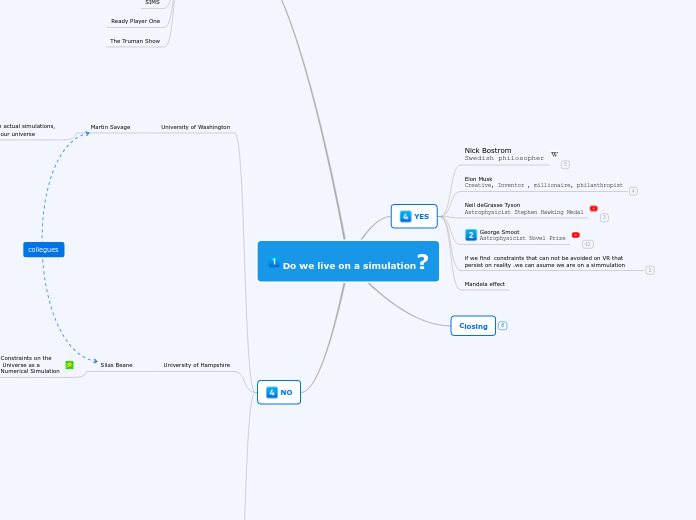Do we live on a simulation?
YES
Elon Musk
Creative, Inventor , millionaire, philanthropist
if we find constraints that can not be avoided on VR that persist on reality .we can asume we are on a simmulation
Mandela effect
Closing
Media
Rick & Morty
Subtopic
Black Mirror
San Junipero (Season 3, Episode 4)
Hang the DJ (Season 4, Episode 4)
Playtest (Season 3, Episode 2)
Matrix
Inception
Paprika
SIMS
Ready Player One
The Truman Show
NO
University of Washington
Martin Savage
if YES, we find present constraints on actual simulations, and find analog limitations evidences on our universe
Supercomputers
lattice quantum chromodynamics,
starting from the fundamental physical laws that govern the universe can simulate only a very small portion of the universe, on the scale of one 100-trillionth of a meter, a little larger than the nucleus of an atom,
But in the future a molecule, an atom, a body.
Those computers, divide space into a four dimension grid, that allows researchers to examine what is called, the strong force, (1/4 fundamental forces of nature ) this binds subatomic particles called quarks, to stick together, until atoms.
underlying lattice if one is used to model the space-time continuum.
University of Hampshire
Silas Beane
Terms
Moore's law
Exponential grouth of raw computer power in time,
(HPC) high-performance computing
(QCD) Quantum Chromodynamics
the fundamental force in nature that gives rise to the strong nuclear force among protons and neutrons,
Lattice Algebraic structure
, partialy ordered set in which every 2 elements have a unique supremum (upper bound or joint), and a unique infimum (lower bound or meet)
CRR
computational resource requirements to CQD
Constraints
fundamental energy scale defined
by the lattice spacing can be orders of magnitude smaller than the Planck scale, in which
case the conflict between quantum mechanics and gravity should be absent
if we have enough computer power in the future we know the classical limit for quantum computer. but, we dont know the future algoritms, or hardware used in the future,
We dont know all Physics laws
We dont know if Universe is finite
Conclusion
The spectrum of the
highest energy cosmic rays
provides the most stringent constraint that we have found on the lattice spacing of a universe simulation,
Zohar Ringel and Dmitry L. Kovrizhin
Quantized gravitational responses, the sign problem, and quantum complexity
thermal Hall conductance
fractional quantum Hall effects
spontaneously broken time-reversal (TR)
“In order to simulate a quantum mechanical system, one would, in general, have to diagonalize this matrix on a computer, which is a computationally difficult task when the size of the matrix becomes large.”
According to the research team’s best approximations, it would require
1 terabyte of RAM to store just 20 spins of a single particle on the quantum level
CONCLUSION
require more atoms than there are in the universe
